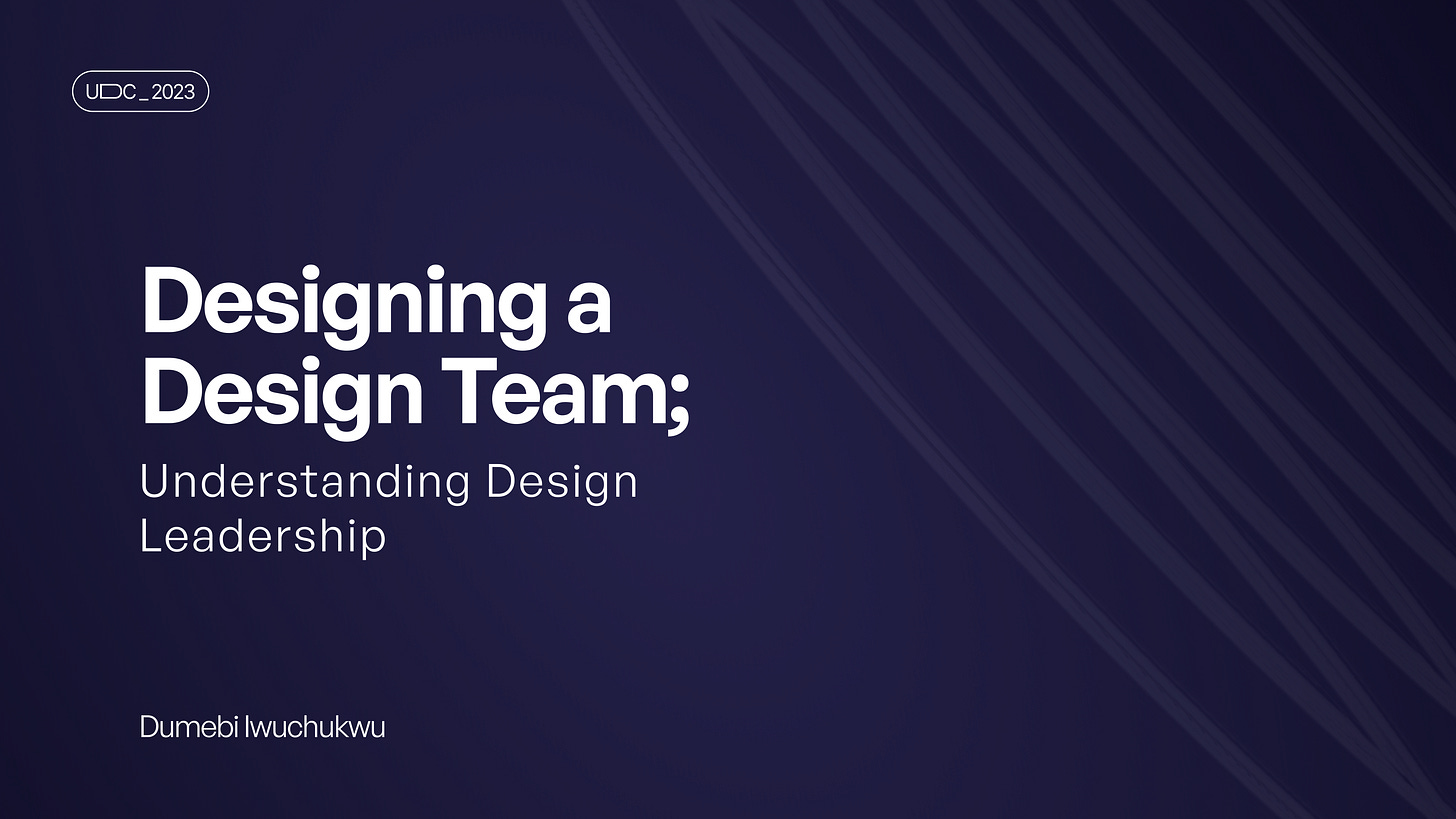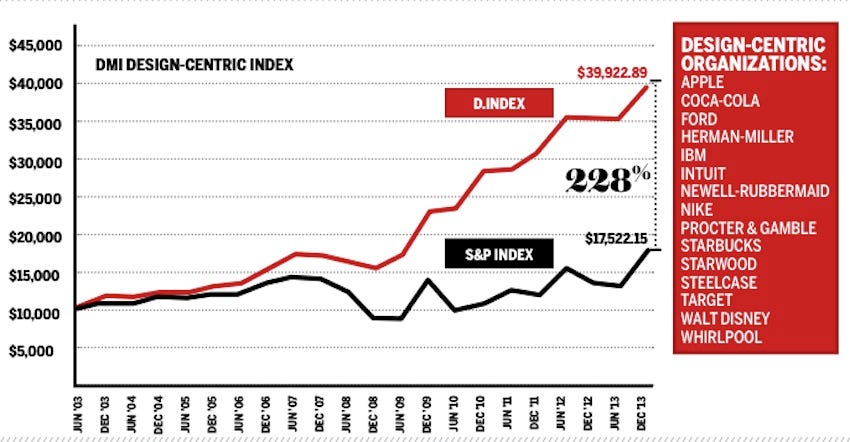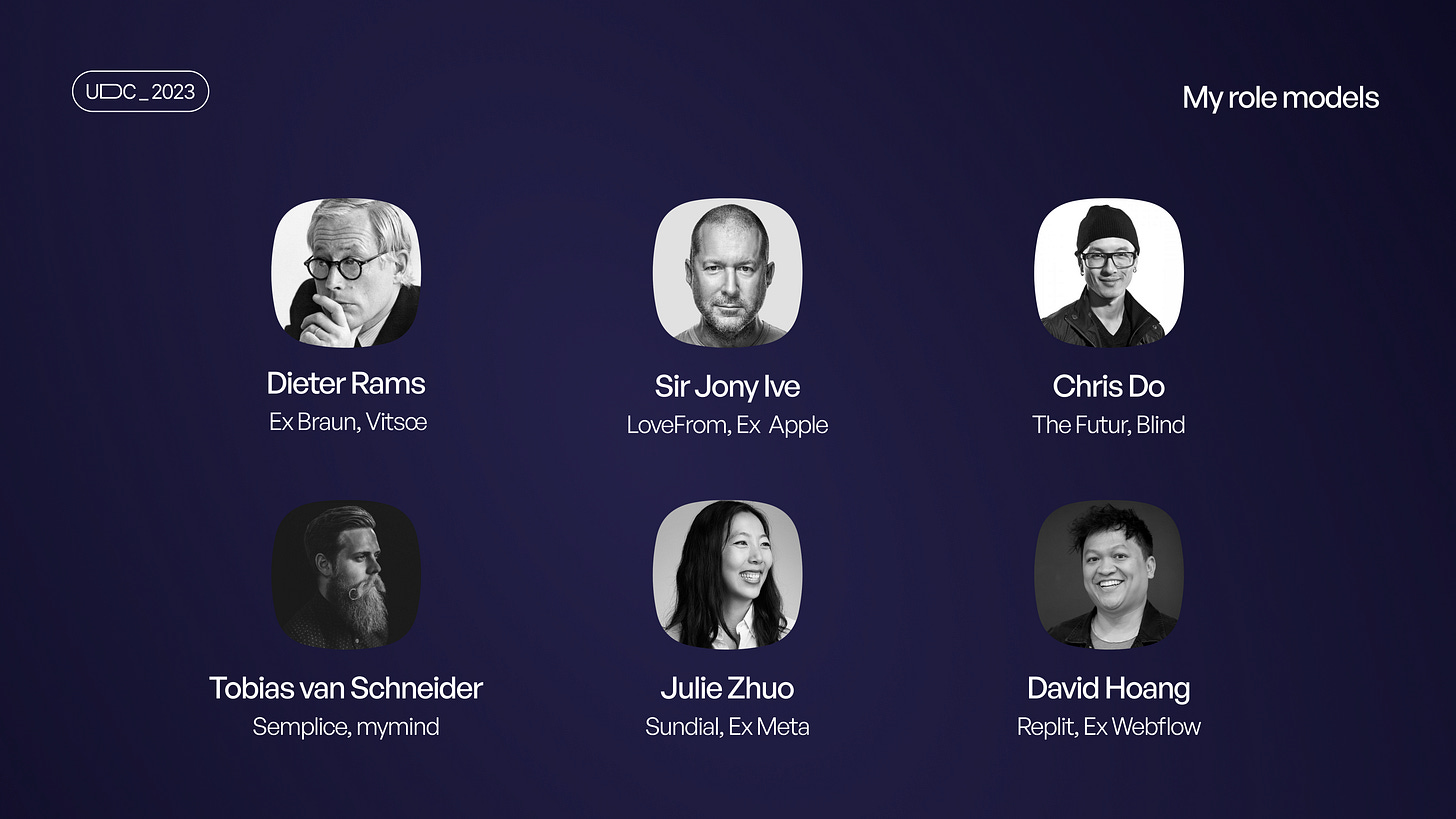Designing a Design Team
Understanding design leadership from the lens of building a design team
On Saturday the 13th of May, I spoke at the Untitled Design Conference 2023 on the topic Designing a Design Team; Understanding Design Leadership. It was an exciting opportunity to talk about my learnings and experience building and leading design teams since 2021.
I’ll be sharing my thoughts from the presentation here with you in this newsletter.
Design Leadership is an interesting job in that it’s a business role first and a design role second. It is more about aligning design goals with business goals - managing people, processes and outcomes - than doing actual design.
Importance of design leadership
Design leadership is essential for driving business performance.
A study by the Design Management Institute and Motiv Strategies found that design-led companies, as defined by the Design Value Index (DVI), outperformed the S&P 500 by 228% over a 10-year period (2004-2014).
The Design Management Institute (DMI) and Motiv Strategies created the Design Value Index (DVI) to identify and track design-led companies. The DVI is a list of publicly traded U.S. companies that meet a set of six design management criteria.
The criteria include:
Design is embedded within the company's organisational structure.
Design leadership is present at senior and divisional levels.
There is a senior-level commitment to design's use as an innovation resource and a force for positive change.
The DMI and Motiv Strategies studied the performance of DVI companies over a 10-year period (2004-2014).
They found that DVI companies outperformed the S&P 500 by 228% over this period.
(Source: Design Management Institute, Motiv Strategies)
This study provides strong evidence that design-led companies can outperform their competitors. It is important to note that the DVI is not a perfect measure of design-led companies. However, it is a valuable tool for identifying companies that are committed to design and innovation.
This performance advantage is also because customers are willing to pay more for well designed products. Users also often perceive aesthetically pleasing products as more usable and valuable. This is called the Aesthetic-Usability Effect.
By investing in design leadership, businesses can improve their products, services, and overall operations. This can lead to increased sales, profits, and customer satisfaction.
Who is a design leader?
The design leaders’s primary role is to define a strong vision for the design team and processes of an organisation. They establishes and upholds the organisation’s design principles and standards while ensuring the design team delivers high-quality work.
The titles of Design Lead, Head of Design, and Chief Design Officer are all used to describe senior-level design positions. The difference in titles is typically based on the size of the design team, the scope of the design responsibilities, and the level of executive authority.
Design Lead
A Design Lead is typically responsible for a small team of designers. They may be responsible for overseeing the design of a specific product or service, or they may be responsible for leading a team of designers who work on a variety of projects.
Head of Design
A Head of Design is typically responsible for a larger team of designers. They may be responsible for overseeing the design of a product line, or they may be responsible for leading a team of designers who work on a variety of projects across the organisation.
Chief Design Officer
A Chief Design Officer is the highest-ranking design executive in an organisation. They are typically responsible for the overall design strategy of the organisation, and they may also be responsible for leading a team of designers who work on a variety of projects.
The titles of Design Lead, Head of Design, and Chief Design Officer are not always used consistently across organisations. In some organisations, the titles may be used interchangeably, while in other organisations, the titles may be used to denote specific levels of responsibility and authority.
Design leadership roles
Functionally the design leader plays four roles; the roles of a leader, manager, coach and operator.
🧙🏾♂️ Leader
As a leader, they work with senior leadership/management to align design goals with business goals. They also make sure that the design goals are clearly defined and communicated to the design team.
They also create an environment of innovation by building a data driven research culture, making sure that every idea and insight is considered and evaluated while adhering to the established design standards. The design leader also inspires the team and creates channels for cross-functional collaboration between the design team and other teams within the organisation.
👩🏾💼 Manager
As a manager, they ensures the team is efficient and cost effective. They do this by hiring, managing the designers, managing the design budget and resources as well as being responsible for firing underperforming designers.
👨🏾🏫 Coach
As a coach, their focus is on building a high performance design team. This involves making sure that the team composition has the relevant skillset to deliver the design and business goals of the organisation.
They provide training and development opportunities for the team and conducts performance reviews to ensure the team is robust enough to handle it’s responsibilities.
👩🏾🎨 Operator
As an operator, they ensures the team delivers high-quality work consistently. They create effective and efficient workflows for successful, high-quality project delivery, plan and lead design projects from concept to launch, and also manage feedback from stakeholders.
How to build a high performance design team
A high performance design team is key to achieving the organisations goals. Here we’ll look at the process for building a design team.
📝 Planning
Building a high performance design team starts from defining the design goals based on the business goals.
These include;
Planning the Objectives and Key Results (OKRs), spotlighting milestones the team needs to hit, goals that will contribute to the milestones, as well the activities they will engage in the meet the goals. The hiring needs of the team should be captured in the OKRs for the relevant period.
Creating a Hiring Plan by defining the roles needed, the required skills for the roles in a JD, interview questions, interview panel, assessment questions. and the timeline for filling the roles. The hiring plan also includes the onboarding plan for integrating the new team member once they are hired.
💼 Hiring
Hiring is the process of recruiting the candidates to fill the open roles in the team.
This involves;
Sourcing candidates via job boards, career pages, social media (esp. Linkedin), employee referral programs, industry conferences and networking events. You can also share job postings with recruiters and partners in your community to recommend a candidate or share with their network. Another option is to find the designers of your favourite apps and products and contact them.
Shortlisting candidate for interviews; this involves reviewing the applications of the candidates, looking through their portfolios and resumes to filter out unqualified candidates. The candidates who demonstrate the required experience and skill are then shortlisted for the interviews.
Conducting Interviews; Shortlisted candidates are taken through the technical interviews, portfolio reviews and culture interviews and are graded according to the defined skills for the role.
Assessments: Tests are then administered to the candidates and assessed.
The Offer is then made to the candidate by the HR/People Ops team, the salary is negotiated and the resumption date is agreed upon.
It’s also important the HR/People Ops team communicates with the candidates that didn’t make it through the process letting them know the team won’t be moving forward with them. If possible, give them feedback on areas they need to improve on to help their chances with other applications.
Onboarding commences once the team member resumes and will include sessions to help them understand the business and their role, meet their colleagues, receive their work tools and integrate into the design team.
🏋🏾♀️ Training
A key part of the design leader’s role is training the team to make sure they are up to date on required skills and they continue to grow their capabilities to serve the organisation.
This involves;
Creating a Team Development Plan; This should define the skills the team will need to develop, the training curriculum, the training budget and the training providers for the team.
Allocating time for the trainings and tracking the progress of the team in the training programme.
It also important to include trainings on design leadership to ensure ease of career growth and succession planning in the team. This will allow team members interested in design leadership to grow into those roles.
📈 Performance management
These are the rituals and processes involved in making sure the team is performing optimally and is able to improve the quality of it’s outputs.
These entails;
1-on-1 meetings; this is an important meeting between the design lead and teammates to resolve issues, give feedback, share relevant information, build trust and help the participants grow in their roles.
Performance reviews; these are formal assessment of the employee's work performance. They help identify strengths and weaknesses, provides opportunity to offer feedback, and sets goals for future performance. This information can also be used to make decisions about promotions, performance improvement plans, and terminations.
Feedback surveys; The team can send out surveys internally to the cross- functional teams they collaborate with to get feedback on the team’s communication, collaboration, speed of delivery and quality of output. This will help the team discover areas friction or under-performance and improve.
Performance improvement plans; this is a plan that helps employees improve their performance. It is typically used when an employee is consistently underperforming, and it outlines the specific steps that the employee needs to take in order to meet expectations. A PIP may include specific goals, deadlines, and benchmarks, as well as a plan for providing the employee with support and resources.
Purpose of the design team
The design team works with other departments, such as marketing, sales, product, and engineering, to understand the company's goals and then implement strategies and creates designs that will help the company achieve those goals.
These are the main business goals the design team helps the business achieve;
💰 Revenue
Designers are empathetic by nature and as such can quickly feel the pulse of the organisations’ customers and designs suitable products and services to meet their needs.
Well-designed websites and products make it easier for customers to find and purchase the organisations's products or services. Superior product designs and user experience also makes the products more effective and makes sales easier. This makes customers fall in love, turning them into advocates for the product.
A design team can help to drive innovation within a company, coming up with new products or services that can help the organisation to grow their revenue. This innovation can also lead to the creating of intellectual property and patents which can be licensed or sold by the organisation.
🚀 Growth
Effective marketing campaigns are essential for any organisation that wants to grow its business. A well-designed campaign will target the right audience with the right message, and it will be visually appealing and engaging. This will help to attract new customers, generate leads, and increase brand awareness
UX is the overall experience that users have when they interact with a product or service. It encompasses everything from the design of the interface to the way the product is used. Great UX makes it easy for users to do what they need to do, and it helps them to have a positive experience. This can lead to increased customer satisfaction and retention.
Design can be used to improve communication in a number of ways. For example, it can be used to create clear and concise information, to make complex ideas easier to understand, and to create a sense of unity and identity. This can help to improve communication within an organisation, as well as with its customers.
In conclusion, design is an important tool that can help organisations to achieve a number of goals. By investing in design, organisations can improve their marketing campaigns, create great user experiences, and improve communication.
✨ Authority
By carefully considering the visual elements of your brand, the team can create a strong and memorable identity that will help the organisation to stand out from the competition and build trust with their customers.
Creating a strong visual identity: A well-designed logo, website, and other marketing materials can help to create a strong visual identity for your brand. This can make your brand more recognisable and memorable, and can help to position you as an authority in your industry.
Communicating your brand's values: Design can also be used to communicate your brand's values. For example, you can use colour, typography, and imagery to create a sense of luxury, trustworthiness, or innovation.
Creating a positive user experience: When people interact with your brand, they should have a positive experience. This means that your website should be easy to use, your products should be well-designed, and your customer service should be excellent. A positive user experience can help to build trust and loyalty with your customers, and can make them more likely to recommend your brand to others.
Standing out from the competition: In today's crowded marketplace, it's important to stand out from the competition. Design can help you to do this by creating a unique and memorable brand identity. This can make your brand more likely to be noticed by potential customers, and can help you to gain a competitive advantage.
Here are some specific examples of how design can contribute to brand authority:
Apple: Apple is one of the most successful brands in the world, and its design is a major part of its success. Apple products are known for their sleek, minimalist design, which communicates a sense of luxury and sophistication. This design helps to position Apple as an authority in the technology industry.
Nike: Nike is another brand that has benefited from strong design. The company's iconic swoosh logo is instantly recognisable, and its products are known for their stylish and athletic design. This design helps to position Nike as a leader in the sportswear industry.
Starbucks: Starbucks is a coffee company that has built a strong brand identity around its design. The company's stores are known for their warm and inviting atmosphere, and its products are packaged in stylish and minimalist designs. This design helps to position Starbucks as a premium coffee brand.
🏆 Recognition
The design team helps increase the brand awareness of the organisation, helping it stand out from it’s competitors and delight it’s customers through well-designed logo and branding assets.
A consistent design identity also helps the customers easily identify the organisation and it’s products and services.
My Design Leadership role models
These are design leaders that has inspire me over the years by the way they modelled great creative leadership, transforming their organisations and the design industry.
They are;
Dieter Rams, renowned industrial designer behind a bunch of iconic products designed for Braun and Vitsœ. His minimalist design style and philosophy has influenced the practice of design, as well as 20th century aesthetics and culture.
Sir Jonny Ive, is an industrial and product designer, former Chief Design officer at Apple, and currently co-founder at LoveFrom. He is also a Chancellor of the Royal College of Art.
Julie Zhuo, former VP of Product Design at Meta, currently Co-founder at Sundial. She’s also the Author of ‘The Making of a Manager’.
Chris Do, is an Emmy award-winning designer, director, CEO and Chief Strategist of Blind and the founder of The Futur—an online education platform with the mission of teaching 1 billion people how to make a living doing what they love.
Tobias van Schneider, Founder at Semplice, Carbonmade and mymind.
David Hoang, Head of Design at Replit and Former Head of Product Design at Webflow
Finally
The ‘portfolio’ of a great design leader is a highly successful team. A team that consistently delivers great brands, products and, valuable user experiences to the customers. A team that contribute to revenue, market share, as well as to the organisations’s authority, and brand recognition.
I’ll end with a quote from the renowned industrial designer, Dieter Rams;
“Indifference towards people and the reality in which they live is actually the one and only cardinal sin in design”
― Dieter Rams
Opportunities
Check out open roles at Stears.
Jumia is hiring for Head of UX & Product Design [Nigeria]
HubSpot is hiring a Director, User Experience (Design Systems) [Remote - USA].




